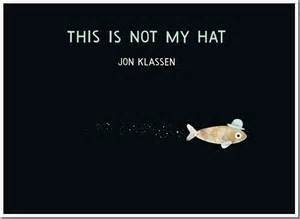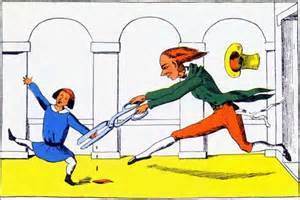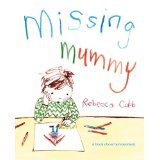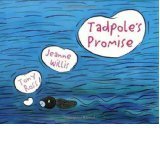Unhappily Ever After? By Pippa Goodhart
Does horror have a place in picture books?
There’s been a lot of recent discussion as to whether or not there are too many unhappy and hopeless endings in books for teenagers. But what about unhappy endings in picture books?

Jon Klassen’s ‘This Is Not My Hat’ won the Kate Greenaway prize at the same time that Kevin Brooks’ controversial book 'The Bunker Diary' won the Carnegie. Both deal in horror. Both could be said to end unhappily.
‘This Is Not My Hat’ is a very beautiful book. It's a very simple book. It's a very powerful book. It’s truly dramatic and exciting. (Spoiler alert!) We are told the story in a few sentences narrated by a little fish who is boasting that he’s stolen a hat from a big fish, but the big fish is asleep and probably won’t notice. But we can see in the pictures that the big submarine shaped fish isn’t asleep: he’s awake! And he’s angry! And he’s going after the little fish into a mass of green weeds … before coming back out with his hat. And that little fish voice has stopped.

Why is that so powerful? Its power is in what is not said or explained. It is in that space left to be filled with the reader’s own imagination. What most of us imagine is a horrible massacre of the little fish by the big one. So it is us, rather than Jon Klassen, making the story end with horror. Is finding horror in ourselves more powerful than being given it from the outside?
A lot of the reviews on Amazon say that this is a book for adults and older children rather than children of the usual picture book age. When I think of my daughters at, say, two to five years old, they would have made that grisly imaginative leap and been upset by it. But would they actually, at some level, enjoyed the thrill of that horror, or just been upset? I don’t know.
One Amazon reviewer took from that book a message of: find out the perpetrator, kill him and eat him. But it's more complex than that. The supposition that the fish has been eaten (and it’s only happened in the reviewer’s mind, remember, not explicitly on the page in any way!) raises the big and important question of fairness. Did the little fish deserve to die for stealing something that wasn’t his, and then cockily boasting that he’d got away with it? Small children have strong opinions about fairness. Where does fairness lie in this case? And is capital punishment fair? It’s all so interesting! I think it’s the interesting moral dilemma in this story that stays with us more than the horror, whereas it was definitely the horrors in Struwwlpeter that have haunted me and has stayed with me long after ‘nice’ books have faded from memory.

[image error] There is the view that childhood is a golden time of innocence, where the nasty side of life doesn’t yet have a place. For some children their early years truly are like that, and I think I’d hesitate to upset things for those children with too early a dose of unhappily ever after. There are plenty of picture book stories that deal in horrors (think of The Owl Babies raising the possibility that Mum has been eaten by a fox!) but in which things are brought to clearly happy endings. The difference here is that we are left still mid-horror, albeit in a way that many would take as black humour more than straight horror.

There are ‘unhappy’ books that are aimed squarely at addressing some real life horrors, of course. Rebecca Cobb’s beautiful ‘Missing Mummy’ shares the misery and misunderstanding and anger of a small girl whose mother has died. I wouldn’t offer that to a child who had no notion yet that a mother could die, but it makes a wonderful discussion point for children who have experienced the death of their mother, or for those who know another child going through that real horror.
Different books are going to suit different children in different situations and at different times, and we adults have a role in guiding the right books to the right children at the right moment. We have the luxury of a huge choice, even within picture books. I think that’s wonderful. But it trips some people up.

Look at the reviews for Jean Willis and Tony Ross’s ‘Tadpole’s Promise’, and you’ll find much greater outrage than for ‘It’s Not My Hat’. I suppose that is because people have picked up what looks like a nice little love story about a tadpole and a caterpillar who promise to love each other for ever and never to change …. And they haven’t thought through the inevitable problems implicit in that set-up! Clearly people have bought the book, and not read it themselves before reading it aloud to a small child audience who are sometimes horrified when the frog eats the butterfly! An outraged adult reader is going to produce an upset child. Maybe some children will be upset even if the reader has warned that this is a story that isn’t going to end happily. But for some the kind of bright child who delights in following an idea through to a logical conclusion, that book is an absolute delight! Besides, the frog isn’t unhappy because it’s oblivious of quiet who it has just eaten. And the butterfly isn’t unhappy because it’s, well, dead. This is a great book to read out loud to students of writing. They tend to gasp and say, ‘but I didn’t think that children’s books could end like that!’
Should they? What do you think?
There’s been a lot of recent discussion as to whether or not there are too many unhappy and hopeless endings in books for teenagers. But what about unhappy endings in picture books?

Jon Klassen’s ‘This Is Not My Hat’ won the Kate Greenaway prize at the same time that Kevin Brooks’ controversial book 'The Bunker Diary' won the Carnegie. Both deal in horror. Both could be said to end unhappily.
‘This Is Not My Hat’ is a very beautiful book. It's a very simple book. It's a very powerful book. It’s truly dramatic and exciting. (Spoiler alert!) We are told the story in a few sentences narrated by a little fish who is boasting that he’s stolen a hat from a big fish, but the big fish is asleep and probably won’t notice. But we can see in the pictures that the big submarine shaped fish isn’t asleep: he’s awake! And he’s angry! And he’s going after the little fish into a mass of green weeds … before coming back out with his hat. And that little fish voice has stopped.

Why is that so powerful? Its power is in what is not said or explained. It is in that space left to be filled with the reader’s own imagination. What most of us imagine is a horrible massacre of the little fish by the big one. So it is us, rather than Jon Klassen, making the story end with horror. Is finding horror in ourselves more powerful than being given it from the outside?
A lot of the reviews on Amazon say that this is a book for adults and older children rather than children of the usual picture book age. When I think of my daughters at, say, two to five years old, they would have made that grisly imaginative leap and been upset by it. But would they actually, at some level, enjoyed the thrill of that horror, or just been upset? I don’t know.
One Amazon reviewer took from that book a message of: find out the perpetrator, kill him and eat him. But it's more complex than that. The supposition that the fish has been eaten (and it’s only happened in the reviewer’s mind, remember, not explicitly on the page in any way!) raises the big and important question of fairness. Did the little fish deserve to die for stealing something that wasn’t his, and then cockily boasting that he’d got away with it? Small children have strong opinions about fairness. Where does fairness lie in this case? And is capital punishment fair? It’s all so interesting! I think it’s the interesting moral dilemma in this story that stays with us more than the horror, whereas it was definitely the horrors in Struwwlpeter that have haunted me and has stayed with me long after ‘nice’ books have faded from memory.

[image error] There is the view that childhood is a golden time of innocence, where the nasty side of life doesn’t yet have a place. For some children their early years truly are like that, and I think I’d hesitate to upset things for those children with too early a dose of unhappily ever after. There are plenty of picture book stories that deal in horrors (think of The Owl Babies raising the possibility that Mum has been eaten by a fox!) but in which things are brought to clearly happy endings. The difference here is that we are left still mid-horror, albeit in a way that many would take as black humour more than straight horror.

There are ‘unhappy’ books that are aimed squarely at addressing some real life horrors, of course. Rebecca Cobb’s beautiful ‘Missing Mummy’ shares the misery and misunderstanding and anger of a small girl whose mother has died. I wouldn’t offer that to a child who had no notion yet that a mother could die, but it makes a wonderful discussion point for children who have experienced the death of their mother, or for those who know another child going through that real horror.
Different books are going to suit different children in different situations and at different times, and we adults have a role in guiding the right books to the right children at the right moment. We have the luxury of a huge choice, even within picture books. I think that’s wonderful. But it trips some people up.

Look at the reviews for Jean Willis and Tony Ross’s ‘Tadpole’s Promise’, and you’ll find much greater outrage than for ‘It’s Not My Hat’. I suppose that is because people have picked up what looks like a nice little love story about a tadpole and a caterpillar who promise to love each other for ever and never to change …. And they haven’t thought through the inevitable problems implicit in that set-up! Clearly people have bought the book, and not read it themselves before reading it aloud to a small child audience who are sometimes horrified when the frog eats the butterfly! An outraged adult reader is going to produce an upset child. Maybe some children will be upset even if the reader has warned that this is a story that isn’t going to end happily. But for some the kind of bright child who delights in following an idea through to a logical conclusion, that book is an absolute delight! Besides, the frog isn’t unhappy because it’s oblivious of quiet who it has just eaten. And the butterfly isn’t unhappy because it’s, well, dead. This is a great book to read out loud to students of writing. They tend to gasp and say, ‘but I didn’t think that children’s books could end like that!’
Should they? What do you think?
Published on October 16, 2014 16:30
No comments have been added yet.



